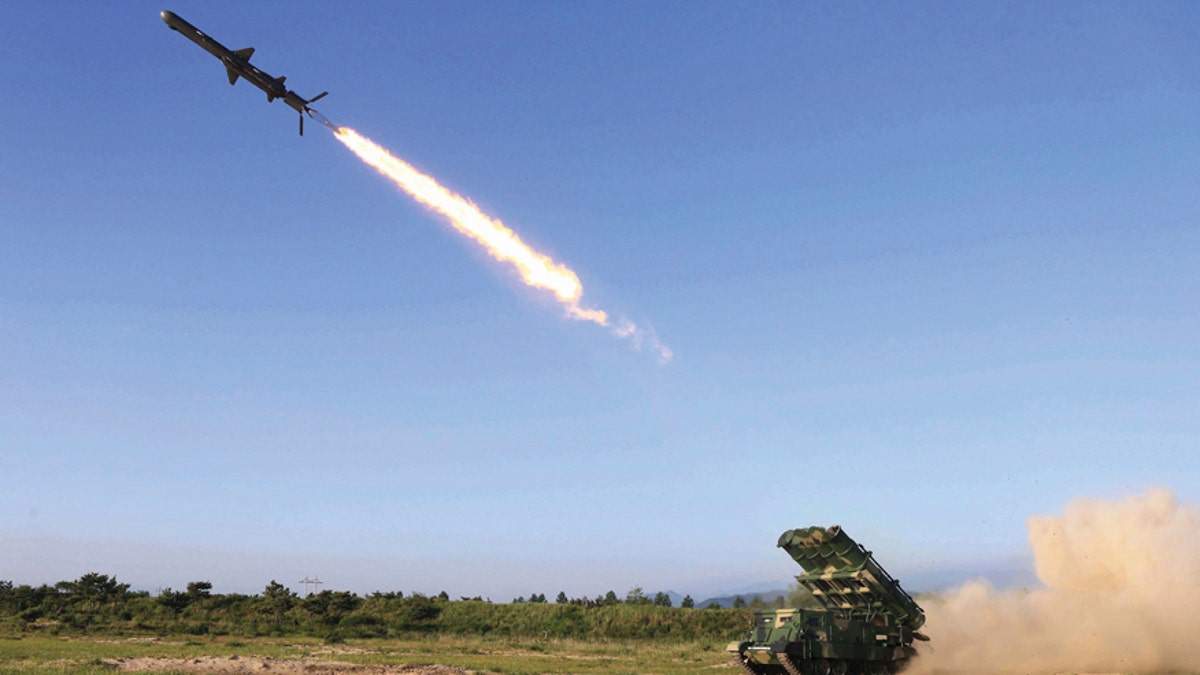
This undated photo distributed on Friday, June 9, 2017, by the North Korean government, shows a test of a new type of cruise missile launch at an undisclosed location in North Korea. I (Korean Central News Agency/Korea News Service via AP)
SEOUL, South Korea – North Korea said Friday it has test-launched a new type of cruise missile capable of striking U.S. and South Korean warships "at will," as South Korea found a suspected North Korean drone near the tense border between the rivals.
The missiles are the fourth new missile system North Korea has disclosed and tested this year, sending a defiant message that it will continue to pursue a weapons program that has rattled its neighbors and Washington.
Related News...
"This new-type cruise rocket is a powerful attack means capable of striking any enemy group of battleships" attempting to attack North Korea and can be used "at will," the North's official Korean Central News Agency said.
It said leader Kim Jong Un observed the launches and that the missiles "accurately detected and hit" floating targets at sea after making "circular flights." The North's claims could not be independently confirmed.
North Korea didn't say how many anti-ship missiles it launched, but South Korean national security director Chung Eui-yong said later Friday the North had fired four short-range missiles on Thursday. South Korea's military said they were fired from the town of Wonsan and flew about 200 kilometers (125 miles) before splashing down between the Korean Peninsula and Japan.
The launch came days after U.S. aircraft carriers USS Carl Vinson and USS Ronald Reagan left those waters after joint exercises with the South Korean navy.
The North Korean missile tests present a difficult challenge to new South Korean President Moon Jae-in, who has expressed a desire to reach out to the North. North Korea, which could have a working nuclear-tipped intercontinental ballistic missile in the next several years, may also be the most urgent foreign policy concern for the Trump administration in Washington, which has been distracted by domestic political turmoil and has insisted that China do more to rein in North Korea's weapons activities.
Moon has sought to expand cross-border civilian exchanges as a way to improve ties, but North Korea on Monday rejected a Seoul civic group's offer to provide anti-malaria supplies to protest South Korea's support of fresh U.N. sanctions adopted last week.
Moon said after the new launches that his government "won't back off even a single step and make any compromise" on the issue of national security. He also warned that North Korea could only face further international isolation and more economic difficulties.
On Friday, South Korea's military found a small flying object that it said was similar in shape and size to one of several North Korean drones discovered in 2014. The Joint Chiefs of Staff said a thorough investigation will be made of the object found south of the Demilitarized Zone that bisects the Koreas.
North Korea has in recent years touted its drone program, a relatively new addition to its arsenal. In 2013, state media said leader Kim had watched a drone attack drill on a simulated South Korean target. The drones found in 2014 were low-tech, but were still considered a potential new security threat, according to South Korean experts.
In what will likely become another source of animosity, Moon's government plans to let two out of four North Korean fishermen recently rescued at sea resettle in South Korea in accordance with their wishes. The two other fishermen, who wanted to return home, were repatriated on Friday.
North Korea often accuses South Korea of kidnapping its citizens or enticing them to defect to the South.
Last month, North Korea premiered a powerful new midrange missile that outside experts said flew higher than any other missile it has tested.
In the following weeks, North Korea launched a solid-fuel midrange missile that can be fired on shorter notice than liquid fuel missiles, and also what it descried a new "precision-guided" missile which experts say is designed with a maneuverable terminal stage meant to frustrate missile defense systems like the U.S. Terminal High Altitude Area Defense that is being deployed in South Korea.
